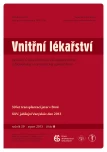Colitis precipitated by Clostridium difficile – a serious current problem
Authors:
P. Husa
Authors‘ workplace:
Klinika infekčních chorob Lékařské fakulty MU a FN Brno, pracoviště Bohunice, přednosta prof. MU Dr. Petr Husa, CSc.
Published in:
Vnitř Lék 2013; 59(8): 743-746
Category:
Overview
Clostridium difficile is currently considered a significant cause of nosocomial infection. The probability of a colonisation of hospitalised patients rises with the length of their stay in hospital and depends on the local epidemiologic situation. Interdisciplinary collaboration is the foundation of the effort to limit the development of this very serious, often fatal disease. The basic element is a rational antibiotic therapy which builds on the knowledge that the administration of antibiotics, even though based on a correct indication, may be fatal in an environment which is massively contaminated by spores of Clostridium difficile. Consequently, the high‑risk antibiotics (such as aminopenicillins, fluoroquinolones or cefalosporins) should be administered only in such cases where they cannot be substituted by antibiotics with a lower risk of CDI.
Key words:
Clostridium difficile infection – vancomycin – metronidazole – fidaxomicin
Sources
1. Savage DC. The microbial flora in the gastrointestinal tract. Prog Clin Biol Res 1981; 77: 893– 908.
2. Bartlett JG, Chang TW, Gurwith M et al. Antibiotic‑associated pseudomembranous colitis due to toxin‑producing clostridia. N Engl J Med 1978; 298: 531– 534.
3. Larson HE, Price AB, Honour P et al. Clostridium difficile and the aetiology of pseudomembranous colitis. Lancet 1978; 1: 1063– 1066.
4. Cartman ST, Heap JT, Kuehne SA et al. The emergence of “hypervirulence” in Clostridium difficile. Int J Med Microbiol 2010; 300: 387– 395.
5. Bishop KD, Castillo JJ. Risk factors associated with Clostridium difficile infection in adult oncology patients with a history of recent hospitalization for febrile neutropenia. Leuk Lymphoma 2012; 53: 1617– 1619.
6. Státní zdravotní ústav, databáze Infekce v ČR – EPIDAT. Dostupné na: www.szu.cz.
7. Vojtilová L, Freibergerová M, Juránková J et al. Analýza souboru pacientů s onemocněním vyvolaným toxinem Clostridium difficile hospitalizovaných na Klinice infekčních chorob v Brně v letech 2007– 2010. Klin Mikrobiol Inf Lék 2011; 17: 208– 213.
8. Vojtilová L, Pýchová M, Freibergerová M et al. Rizikové faktory rekurentního a těžkého průběhu kolitidy vyvolané infekcí Clostridium difficile. Vnitř Lék 2013; 59: 23– 30.
9. Beneš J, Husa P, Nyč O. Doporučený postup diagnostiky a léčby kolitidy vyvolané Clostridium difficile. Klin Mikrobiol Inf Lék 2012; 18: 160– 167.
10. Bauer MP, Kuijper EJ, van Dissel JT. European Society of Clinical Microbiology and Infectious Diseases (ESCMID): treatment guidance document for Clostridium difficile infection (CDI). Clin Microbiol Infect 2009; 15: 1067– 1079.
11. Bauer MP, Notermans DW, van Benthem BHet al. ECDIS Study Group. Clostridium difficile infection in Europe: a hospital‑based survey. Lancet 2011; 377: 63– 73.
12. Nyč O, Pituch H, Matějková J et al. Clostridium difficile PCR ribotype 176 in the Czech Republic and Poland. Lancet 2011; 377: 1407.
13. Louie TJ, Miller MA, Mullane KM et al. Fidaxomicin versus vancomycin for Clostridium difficile infection. N Engl J Med 2011; 364: 422– 431.
14. Polák P, Freibergerová M, Juránková J et al. První zkušenosti s fekální bakterioterapií v léčbě relabující pseudomembranózní kolitidy způsobené Clostridium difficile. Klin Mikrobiol Inf Lék 2011; 17: 214– 217.
Labels
Diabetology Endocrinology Internal medicineArticle was published in
Internal Medicine

2013 Issue 8
Most read in this issue
- Liver transplants in tumours and alcoholic cirrhoses
- Immunosuppression after liver transplant, now and in future
- New drugs in type 2 diabetes mellitus therapy
- Liver transplant indication and waiting list inclusion
